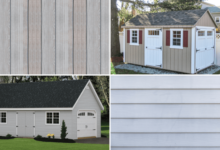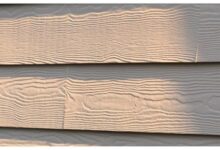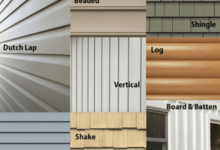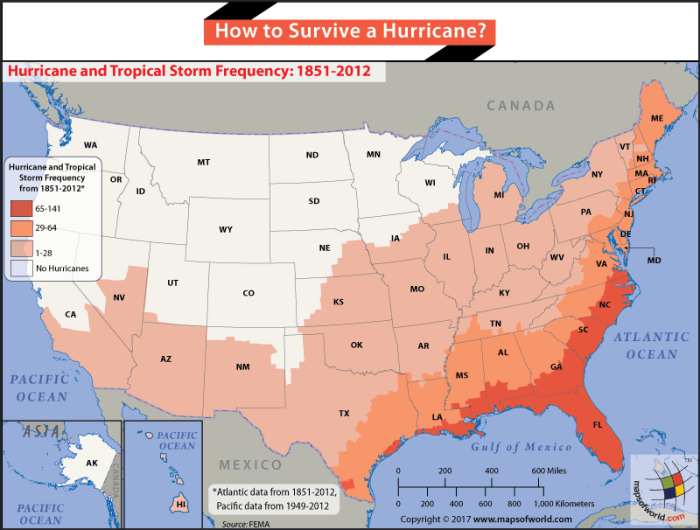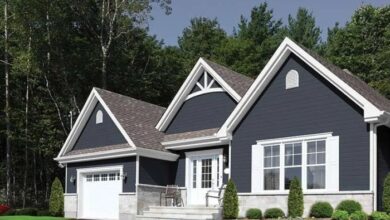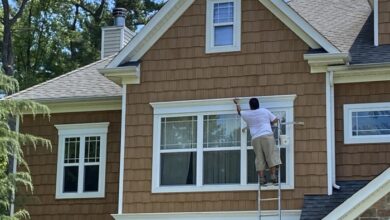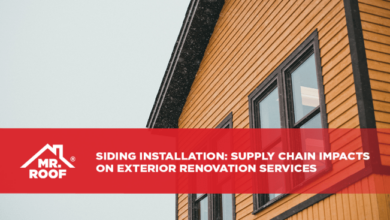Aluminum Siding Repair A Comprehensive Guide
Aluminum Siding Repair: Don’t let damaged siding detract from your home’s curb appeal. This comprehensive guide dives deep into the world of aluminum siding repair, equipping you with the knowledge and skills to tackle everything from minor dents to major replacements. We’ll explore common causes of damage, effective repair techniques, and cost-saving preventative measures. Whether you’re a seasoned DIYer or a homeowner seeking professional advice, this guide will empower you to restore your home’s exterior to its former glory.
From understanding the nuances of different damage types—dents, scratches, holes, cracks, and fading—to mastering repair techniques like dent removal, patching, and caulking, we’ll cover it all. We’ll also walk you through assessing your siding’s condition, choosing the right materials, and even tackling advanced scenarios such as repairing water damage and replacing damaged panels. By the end, you’ll be confident in your ability to handle any aluminum siding challenge.
Understanding Aluminum Siding Damage
Aluminum siding, a popular choice for its durability and low maintenance, isn’t impervious to damage. Understanding the common causes and types of damage is crucial for effective repair and maintaining your home’s curb appeal. Ignoring even minor issues can lead to more extensive and costly problems down the line. This section will equip you with the knowledge to assess the condition of your aluminum siding and determine the best course of action.Aluminum siding damage stems from a variety of sources, often interacting to accelerate deterioration.
The most prevalent culprits are impact, weather exposure, and the inevitable effects of aging. Understanding these causes allows for preventative measures and informed repair strategies.
Causes of Aluminum Siding Damage
Impact damage is perhaps the most readily apparent. Anything from a stray baseball to a falling tree branch can leave noticeable dents, scratches, or even holes in your siding. Weather, however, is a more insidious enemy. Prolonged exposure to sun, rain, snow, and ice can lead to fading, cracking, and warping. Hailstorms can cause significant damage, leaving behind a pockmarked surface.
Finally, age itself contributes to degradation. Over time, the aluminum can become brittle, increasing its susceptibility to damage from other sources. UV radiation from the sun gradually weakens the material, leading to discoloration and loss of structural integrity.
Types of Aluminum Siding Damage
The types of damage observed vary widely in severity and appearance. Dents are common, ranging from shallow indentations to deep, misshapen areas. Scratches, often caused by accidental contact or rubbing, can mar the surface’s aesthetic appeal. Holes, ranging from small punctures to larger gaps, compromise the siding’s protective barrier. Cracks, usually appearing as fine lines or larger fissures, indicate weakening and potential structural failure.
Fading, a gradual loss of color, is often the result of prolonged sun exposure. This discoloration isn’t just cosmetic; it signals degradation of the protective coating.
Severity and Repair of Aluminum Siding Damage
The following table summarizes different types of aluminum siding damage, categorizing their severity, common causes, and appropriate repair methods. Understanding this distinction is critical for effective and cost-efficient repairs. Minor issues can often be addressed with simple DIY solutions, while severe damage might necessitate professional intervention.
| Damage Type | Severity | Cause | Repair Method |
|---|---|---|---|
| Small Dent | Minor | Impact (e.g., small rock) | Gentle tapping with a rubber mallet and putty |
| Large Dent | Moderate | Impact (e.g., falling branch) | Replacement of the damaged panel |
| Crack | Moderate to Severe | Impact, age, extreme temperature fluctuations | Repair with aluminum sealant or panel replacement |
| Hole | Severe | Impact, animal damage | Patching with aluminum sheet metal or panel replacement |
Assessing Repair Needs
Aluminum siding, while durable, isn’t impervious to damage. Regular inspection is crucial for maintaining its aesthetic appeal and structural integrity, preventing minor issues from escalating into costly replacements. A systematic approach ensures thoroughness and helps prioritize repairs, maximizing your investment in your home’s exterior.A comprehensive inspection should be conducted at least annually, ideally during spring and fall. This timing allows for the detection of damage caused by harsh weather conditions throughout the year.
This proactive approach saves money and prevents further deterioration.
Systematic Siding Inspection
Begin your inspection at a high vantage point, such as a ladder or second-story window, to assess the overall condition of the siding. Then, systematically work your way down, examining each panel closely. Look for inconsistencies in color, texture, or alignment. Pay particular attention to areas prone to damage, such as corners, edges, and areas near gutters and downspouts.
Explore the different advantages of Cedar Shake Siding that can change the way you view this issue.
Using binoculars can aid in spotting small cracks or dents from a distance.
Damage Identification Checklist
Before starting your inspection, it’s helpful to have a checklist to ensure nothing is overlooked. This checklist provides a framework for a detailed assessment. The goal is to identify the extent and severity of the damage. Prioritizing repairs based on severity is key for efficient and effective maintenance.
- Cracks and Holes: Note the size, location, and number of cracks and holes. Small cracks might only require sealant, while larger ones may need panel replacement.
- Dents and Scratches: Assess the depth and severity of dents and scratches. Minor imperfections might be easily repaired with fillers, while deep dents may require panel replacement.
- Loose or Damaged Fasteners: Check all screws and nails, tightening loose ones or replacing those that are rusted or damaged. Loose fasteners can lead to further damage during high winds.
- Peeling Paint or Corrosion: Note any areas with peeling paint or signs of corrosion. Corrosion indicates a need for immediate attention to prevent further damage. Addressing these areas early can significantly extend the siding’s lifespan.
- Water Damage: Check for any signs of water damage, such as discoloration, swelling, or mold growth. Water damage can cause significant structural problems if left untreated.
Repair vs. Replacement Decision Flowchart
The decision to repair or replace damaged aluminum siding depends on several factors, including the extent of the damage, the cost of repair versus replacement, and the overall condition of the siding. A clear decision-making process can save time and money. For example, a few small dents might be easily repaired, while extensive damage across multiple panels would likely necessitate replacement.
A simple rule of thumb: If the cost of repair exceeds 50% of the cost of replacing the affected section, replacement is usually the more economical option.
| Damage Severity | Repair Cost (Estimate) | Replacement Cost (Estimate) | Decision |
|---|---|---|---|
| Minor dents and scratches (single panel) | $50 – $100 | $200 – $300 | Repair |
| Significant cracking and corrosion (multiple panels) | $300 – $500 | $1000 – $1500 | Replacement (consider section) |
| Extensive damage, water intrusion (large area) | $1000+ | $3000+ | Replacement (consider full wall) |
Repair Techniques and Materials
Aluminum siding, while durable, is susceptible to damage. Understanding the appropriate repair techniques and materials is crucial for restoring its aesthetic appeal and protecting your home’s exterior. Choosing the right approach depends on the type and extent of the damage. From minor dents to significant holes, a systematic approach ensures a long-lasting repair.Repairing aluminum siding involves a combination of techniques, each requiring specific tools and materials.
Effective repairs not only restore the siding’s appearance but also maintain its protective function against the elements. Properly executed repairs prevent further damage and extend the lifespan of your siding.
Dent Removal
Minor dents can often be repaired without replacing the siding panel. This typically involves using a specialized tool to gently coax the dented area back into shape. A rubber mallet, a suction cup dent puller, or even a carefully applied heat source (like a hairdryer) can effectively address superficial dents. For stubborn dents, a combination of these methods might be necessary.
It’s important to work gradually and avoid applying excessive force, which could cause further damage or cracking.
Patching, Aluminum Siding Repair
More significant damage, such as holes or large cracks, requires patching. This involves cutting away the damaged section and replacing it with a patch of similar material. Aluminum patches are readily available in various sizes and shapes, making them ideal for precise repairs. Proper preparation of the surface is essential for a successful patch. This includes cleaning the area to remove any dirt, debris, or loose paint, ensuring a strong bond between the patch and the existing siding.
Caulking
Caulking is vital for sealing gaps and cracks around windows, doors, and other areas where the siding meets other building components. This prevents water infiltration, which can lead to rot and further damage. Choosing a high-quality, weather-resistant caulk is essential. Silicone-based caulk is a popular choice due to its durability and flexibility. Applying caulk neatly and smoothly is crucial for both aesthetics and functionality.
Excess caulk should be carefully removed to maintain a clean finish.
Patching Materials Comparison
Several materials can be used for patching aluminum siding. Aluminum patches offer the most seamless repair, matching the siding’s material and color. However, other materials, such as epoxy putty or specialized aluminum repair kits, can also provide effective solutions, particularly for smaller repairs. The choice of patching material depends on factors such as the size and location of the damage, as well as the desired level of permanence.
Aluminum patches generally offer superior longevity and weather resistance compared to putty-based options.
Patching a Small Hole: Step-by-Step Procedure
Before beginning any repair, it’s crucial to prepare the area. This involves cleaning the damaged section thoroughly and allowing it to dry completely. A clean surface ensures proper adhesion of the patching material. Proper preparation is vital for a successful repair, minimizing the risk of future problems.
- Step 1: Preparation: Clean the area around the hole with a wire brush and degreaser to remove any dirt, loose paint, or debris. Allow the area to dry completely.
- Step 2: Cutting: Using tin snips, carefully cut a clean, square or rectangular section around the hole, ensuring the cut edges are straight and even. This provides a clean, well-defined area for the patch.
- Step 3: Patch Application: Measure and cut an aluminum patch slightly larger than the opening. Apply a high-quality aluminum-compatible adhesive to the back of the patch and carefully position it over the hole. Ensure the patch is flush with the surrounding siding.
- Step 4: Securing: Use aluminum rivets or self-tapping screws to secure the patch in place. If using screws, use a sealant to prevent water from entering through the screw holes.
- Step 5: Finishing: Once the adhesive is fully cured, apply a touch-up paint to match the existing siding color, ensuring a seamless and aesthetically pleasing repair.
Advanced Repair Scenarios
Repairing severely damaged aluminum siding presents unique challenges beyond simple dent removal or minor crack patching. The complexity increases significantly when dealing with extensive damage, water intrusion, or repairs near critical areas like windows and doors. Understanding these advanced scenarios is crucial for achieving a durable and aesthetically pleasing repair.
Severe damage often necessitates more than just surface-level fixes. This might involve replacing entire sections of siding, dealing with underlying water damage, and ensuring proper sealing to prevent future issues. The process requires specialized tools and a keen eye for detail to ensure a seamless integration of the repaired area with the existing siding. This section details the steps involved in handling such intricate repair work.
Replacing a Damaged Aluminum Siding Panel
Replacing a damaged panel involves careful removal of the affected section, precise measurement for a replacement, and secure installation to maintain the integrity of the siding system. First, the damaged panel must be carefully removed, taking care not to damage adjacent panels or the underlying structure. This usually involves loosening fasteners and gently prying the panel away. Next, accurate measurements are taken to ensure the replacement panel fits perfectly.
Finally, the new panel is installed, ensuring proper alignment and secure fastening. Using the correct fasteners and techniques prevents future issues like leaks or loose panels. For example, using self-tapping screws of the correct length and applying a weather-resistant sealant around the edges of the new panel ensures a watertight seal.
Addressing Water Damage Behind Aluminum Siding
Water damage behind aluminum siding is a serious issue that can lead to structural problems and mold growth. Identifying the source of the leak is the first critical step. This may involve carefully inspecting the siding for cracks or gaps, checking the caulking around windows and doors, and examining the flashing around penetrations in the siding. Once the source is located, the damaged area must be thoroughly dried and repaired.
This may involve removing sections of siding, repairing damaged sheathing, and applying a mold inhibitor before reinstalling the siding. Failure to properly address water damage can lead to costly repairs down the line, including potential structural damage to the underlying wall framing. A real-life example is a homeowner discovering water damage after a heavy storm, leading to the removal of several siding panels, repair of rotted wood, and professional remediation of mold growth before the siding could be reinstalled.
Repairing Siding Around Windows and Doors
Repairing aluminum siding around windows and doors requires extra care to maintain a watertight seal. These areas are particularly vulnerable to leaks due to movement and expansion/contraction. The process often involves carefully removing old caulking, cleaning the surfaces, and applying new, high-quality caulk designed for exterior use. It is also crucial to ensure proper flashing is in place to direct water away from the window or door frame.
Failure to properly seal these areas can lead to water damage to the surrounding framing and interior walls. For instance, inadequate caulking around a window can result in water seeping into the wall cavity, causing rot and mold growth, necessitating extensive and costly repairs.
Prevention and Maintenance
Aluminum siding, while durable, requires proactive care to maintain its appearance and extend its lifespan. Neglecting maintenance can lead to costly repairs down the line, impacting both the aesthetic appeal and structural integrity of your home. Regular inspection and cleaning are key to preventing significant damage and preserving your investment. Proactive measures are far more cost-effective than reactive repairs.Preventing damage to your aluminum siding involves a multi-pronged approach focusing on both protecting the siding itself and addressing environmental factors that can cause deterioration.
This includes regular cleaning to remove dirt and debris, prompt attention to any signs of damage, and strategic landscaping to minimize potential impact.
Protecting Aluminum Siding from Damage
Preventing damage begins with understanding the common causes of aluminum siding issues. Impacts from lawn equipment, falling branches, and even hail can cause dents and scratches. Severe weather, such as strong winds and heavy snow, can also contribute to damage. Therefore, proactive steps are crucial to minimize these risks. For instance, regularly trimming overhanging branches reduces the risk of impact damage.
Similarly, storing lawn equipment carefully can prevent accidental scratches. Consider installing protective barriers, such as strategically placed landscaping, to shield the siding from potential hazards.
Regular Cleaning and Maintenance
Regular cleaning is paramount in maintaining the pristine condition of your aluminum siding. Dirt, grime, and pollutants not only detract from the aesthetic appeal but can also accelerate deterioration. A build-up of debris can trap moisture, leading to corrosion and potential damage. A thorough cleaning, ideally twice a year (spring and fall), is recommended.
Aluminum Siding Cleaning Schedule
| Maintenance Task | Frequency |
|---|---|
| Cleaning (with soap and water) | Twice yearly (Spring & Fall) |
| Inspection for damage (dents, scratches, loose panels) | Twice yearly (Spring & Fall) |
| Caulk inspection and repair (around windows and doors) | Annually |
| Gutter cleaning (to prevent water damage) | Twice yearly (Spring & Fall) |
Safe and Effective Cleaning Process
Cleaning aluminum siding is straightforward but requires the right approach to avoid damaging the surface. Begin by rinsing the siding with a garden hose to remove loose dirt and debris. Then, mix a mild detergent (like dish soap) with water in a bucket. Use a soft-bristled brush or sponge to gently scrub the siding, paying close attention to areas with heavy grime buildup.
Avoid abrasive cleaners or scrub brushes, which can scratch the aluminum. After scrubbing, rinse thoroughly with clean water to remove all traces of soap. Allow the siding to air dry completely. For stubborn stains, consider using a pressure washer, but maintain a safe distance and use a low-pressure setting to prevent damage. Remember to always test any cleaning solution on a small, inconspicuous area first to ensure it doesn’t harm the finish.
Cost Considerations
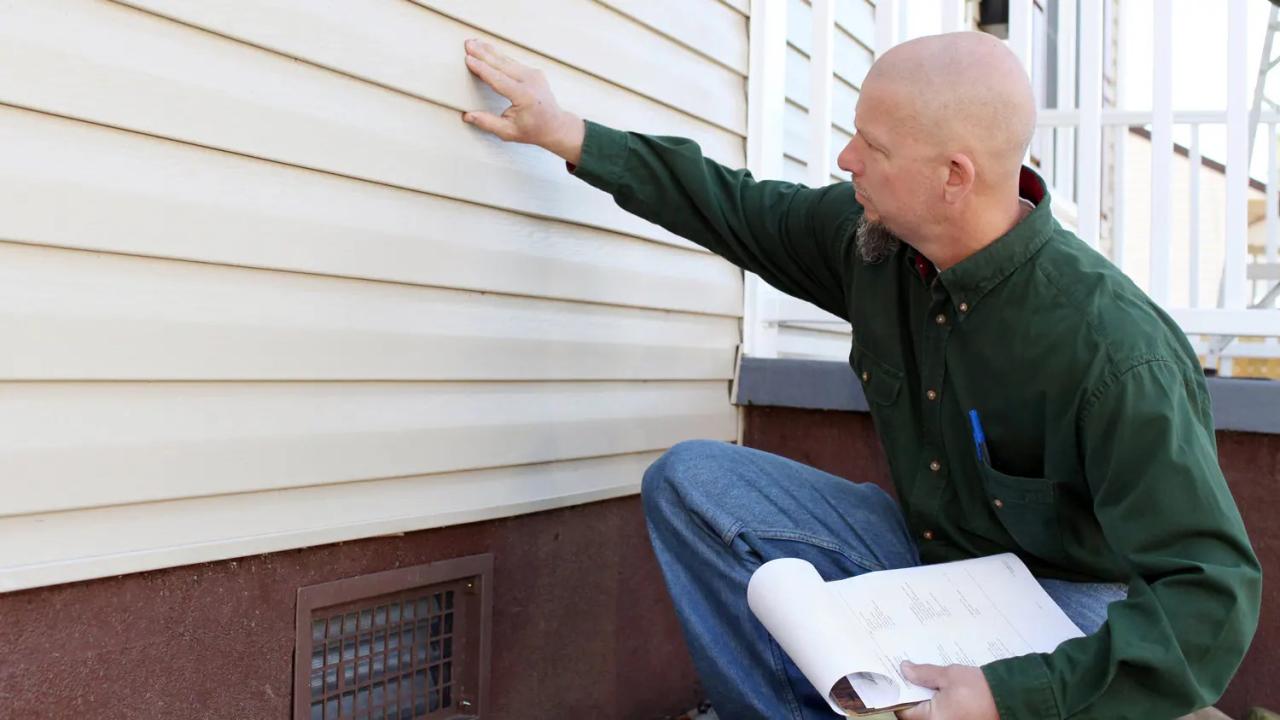
Repairing aluminum siding can significantly impact your home’s budget, depending on the extent of the damage and the chosen repair method. Understanding the cost breakdown is crucial for effective financial planning and ensuring a successful repair project. This section will Artikel the various cost factors involved, comparing DIY versus professional approaches and highlighting the long-term financial benefits of preventative maintenance.
Cost Breakdown of Aluminum Siding Repair
Several factors contribute to the overall cost of aluminum siding repair. Labor costs typically represent a substantial portion of the total expense, varying based on the complexity of the repair and the professional’s hourly rate. Material costs depend on the type and quantity of materials needed, including replacement panels, sealant, and fasteners. For example, repairing a small dent might cost only a few dollars in materials, while replacing a large section of damaged siding could cost hundreds.
Additional costs may include equipment rental (if undertaking DIY repairs), permits (depending on local regulations), and disposal fees for damaged materials. A comprehensive estimate should include all these components.
DIY Repair Versus Professional Services
Undertaking aluminum siding repairs yourself can initially seem cost-effective, primarily due to the absence of labor charges. However, this approach often necessitates purchasing specialized tools and materials, which can quickly add up. Furthermore, improper repair techniques can lead to further damage and ultimately increase the long-term costs. Hiring a professional, while more expensive upfront, guarantees expertise, ensuring the repair is done correctly the first time, minimizing the risk of future issues and potentially saving money in the long run.
For instance, a homeowner attempting a complex repair might inadvertently cause more damage, requiring a professional intervention at a higher cost than a straightforward initial repair.
Factors Influencing Repair Costs
The overall cost of aluminum siding repair is significantly influenced by various factors. The extent of the damage is paramount; minor dents or scratches are significantly cheaper to repair than extensive damage requiring panel replacement. The size of the affected area directly correlates with material and labor costs. The accessibility of the damaged area also plays a role; repairs on higher floors or hard-to-reach areas often involve additional scaffolding or specialized equipment, increasing labor costs.
Finally, geographic location can affect both material and labor costs, with some areas having higher costs of living and material prices. A rural area might have higher travel costs for a professional.
Long-Term Savings Through Preventative Maintenance
Regular preventative maintenance significantly reduces the likelihood of extensive and costly aluminum siding repairs in the future. Simple measures like cleaning the siding annually to remove dirt and debris, inspecting for damage, and promptly addressing minor issues prevent them from escalating into larger, more expensive problems. For example, a small crack ignored could lead to water damage, necessitating costly panel replacement.
By proactively addressing minor issues, homeowners can avoid substantial repair bills down the line, making preventative maintenance a cost-effective long-term investment. The cost of annual cleaning and minor repairs is far less than the expense of major repairs or complete siding replacement.
Visual Aids
Understanding the visual characteristics of aluminum siding damage is crucial for accurate assessment and effective repair. Proper identification of the damage type guides the selection of appropriate repair techniques and materials, ultimately saving time and resources. This section provides detailed descriptions of common damage types and the tools used in their remediation.Aluminum siding damage manifests in various ways, often revealing clues about the underlying cause.
Careful observation of color changes, textural alterations, and surface irregularities can pinpoint the problem and inform the repair strategy.
Aluminum Siding Damage Appearance
Damaged aluminum siding exhibits a range of visual cues. Dents, for instance, appear as localized depressions in the siding’s surface, often accompanied by a slight change in the metallic sheen. Scratches, on the other hand, present as linear abrasions, potentially exposing the underlying metal or paint. More severe damage, such as punctures, involves complete penetration of the siding material, creating holes of varying sizes.
Furthermore, fading, characterized by a loss of vibrancy in the siding’s original color, is often observed in areas exposed to prolonged sunlight. This fading may appear uneven, with some areas exhibiting more significant color loss than others. Finally, corrosion, typically appearing as discoloration, pitting, or flaking, indicates a chemical reaction, often related to moisture exposure. The affected areas may display a whitish, brownish, or even greenish hue depending on the type and extent of the corrosion.
The texture of the corroded area may feel rougher or more pitted compared to the surrounding undamaged sections.
Tools and Materials for Aluminum Siding Repair
The tools and materials used in aluminum siding repair are specialized to address the specific nature of the damage. A putty knife, for example, is used to apply and smooth patching compounds. Its rigid, flat blade allows for precise application and leveling of the filler material, ensuring a smooth surface for subsequent painting. A hammer, often used in conjunction with a metal punch, helps to carefully reshape dents or straighten out minor bends.
The hammer’s controlled impact force, combined with the precision of the punch, allows for gentle manipulation of the aluminum siding without causing further damage. For cutting and trimming aluminum siding, tin snips are indispensable. Their sharp, hardened blades are specifically designed to cleanly cut through the aluminum sheet without creating excessive burrs or jagged edges. Additionally, aluminum siding repair often involves the use of specialized adhesives and sealants.
These products are formulated to bond effectively with aluminum and create a watertight seal, preventing further damage and corrosion. These sealants often come in various colors to match the existing siding, ensuring a seamless and aesthetically pleasing repair. Finally, a selection of high-quality paints, specifically designed for exterior use on aluminum, are crucial for protecting the repaired area from the elements.
These paints are formulated to withstand UV exposure and moisture, providing long-lasting protection and maintaining the aesthetic appeal of the siding.
Wrap-Up: Aluminum Siding Repair
Mastering aluminum siding repair isn’t just about fixing cosmetic flaws; it’s about protecting your home’s structural integrity and increasing its value. By understanding the causes of damage, employing the right repair techniques, and implementing preventative maintenance strategies, you can significantly extend the lifespan of your aluminum siding and save money in the long run. Remember, a well-maintained exterior not only enhances your home’s beauty but also safeguards it from the elements.
So, equip yourself with the knowledge you’ve gained here and get started on that sparkling, damage-free exterior!

